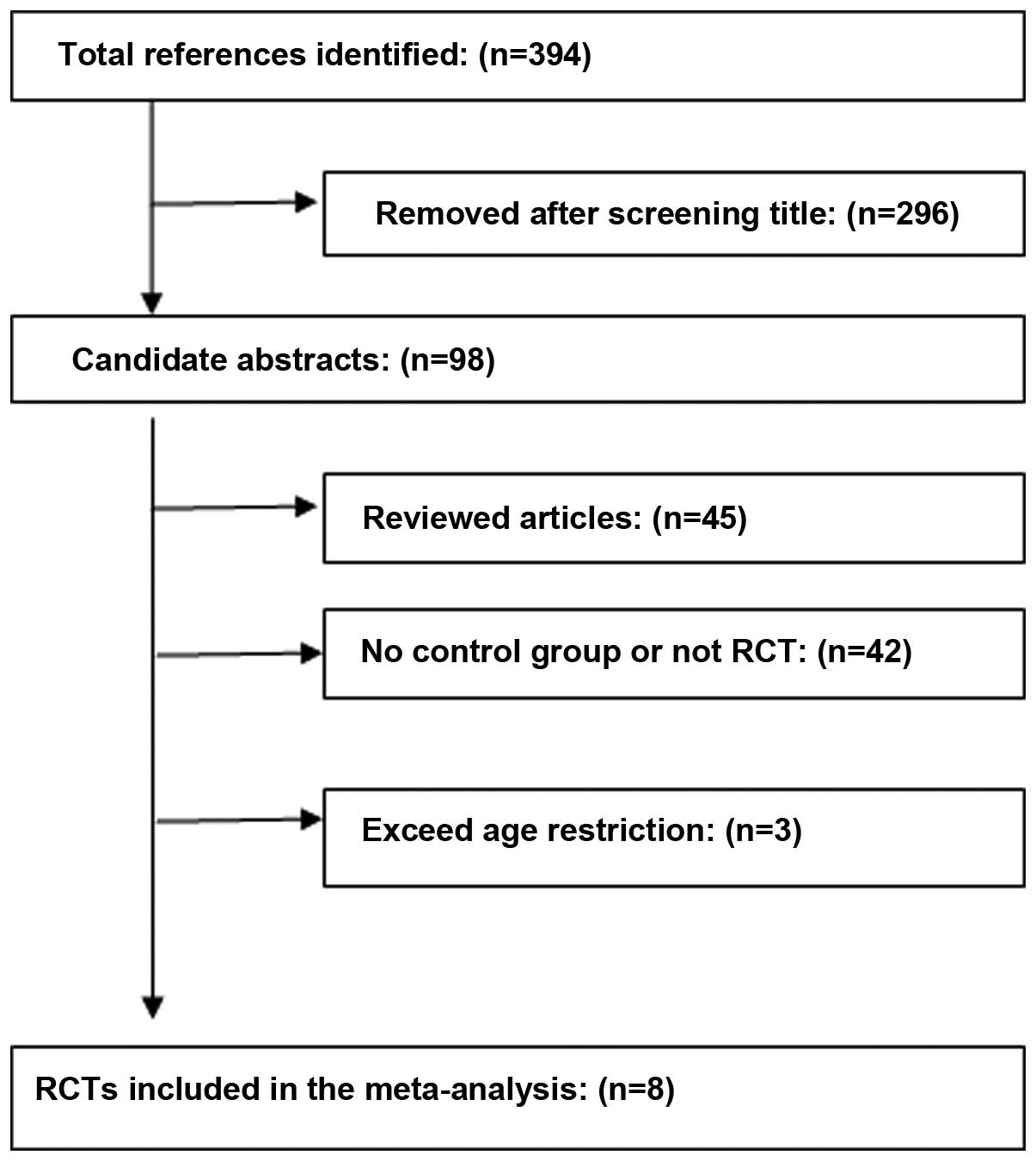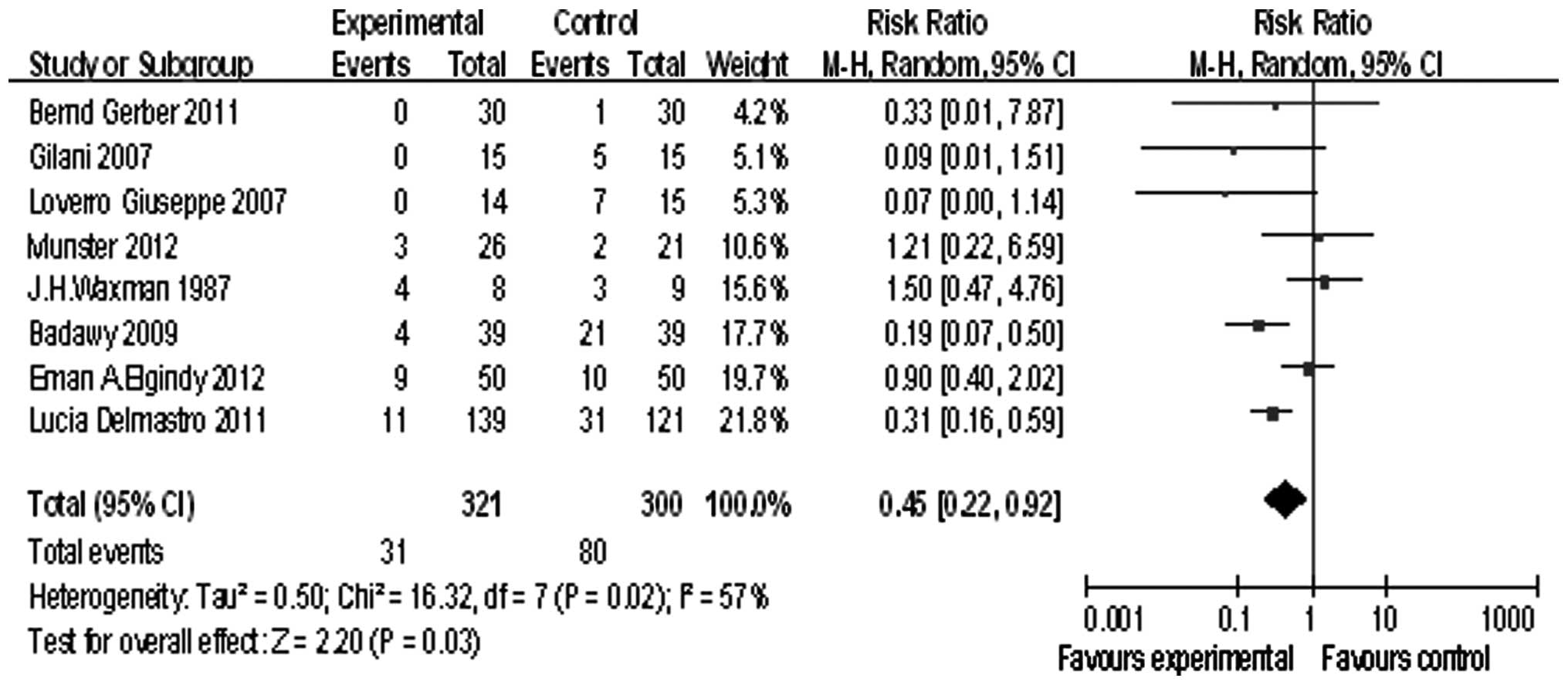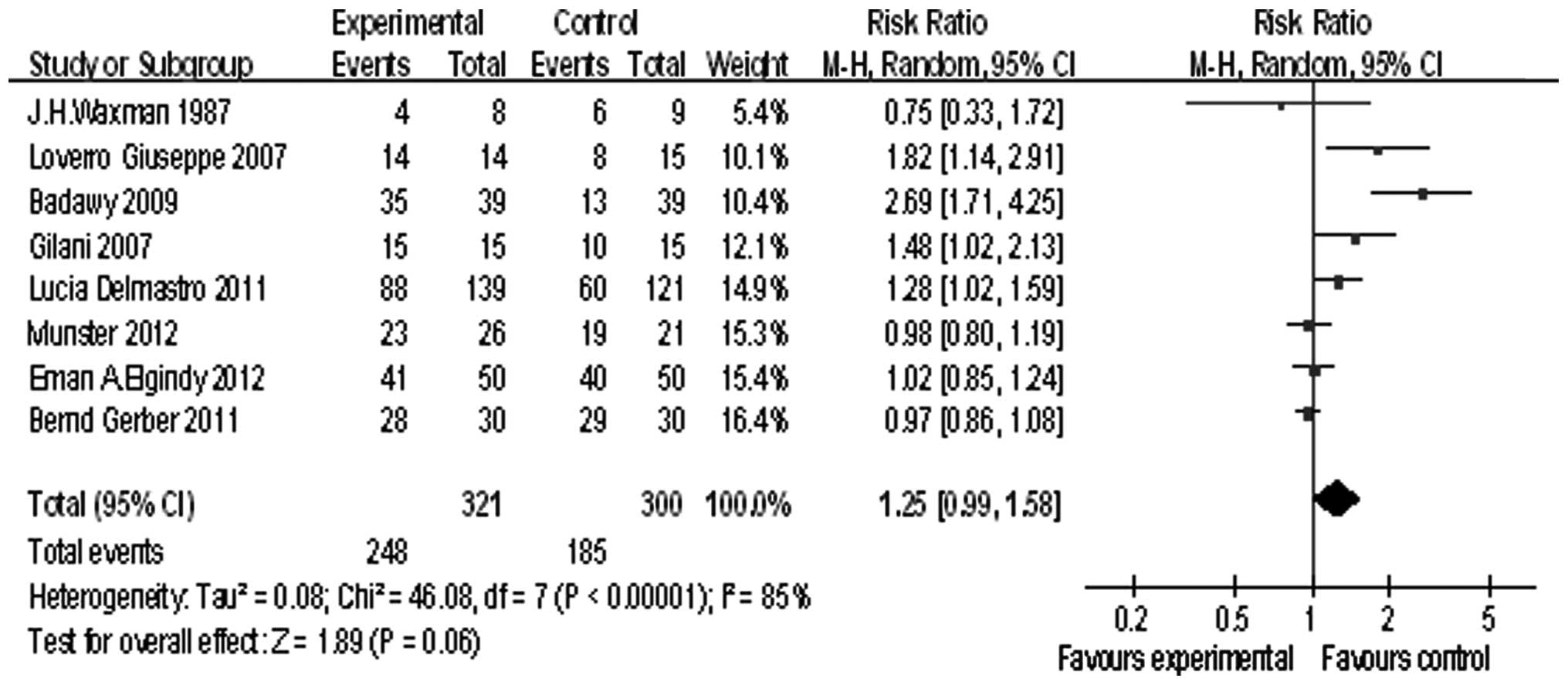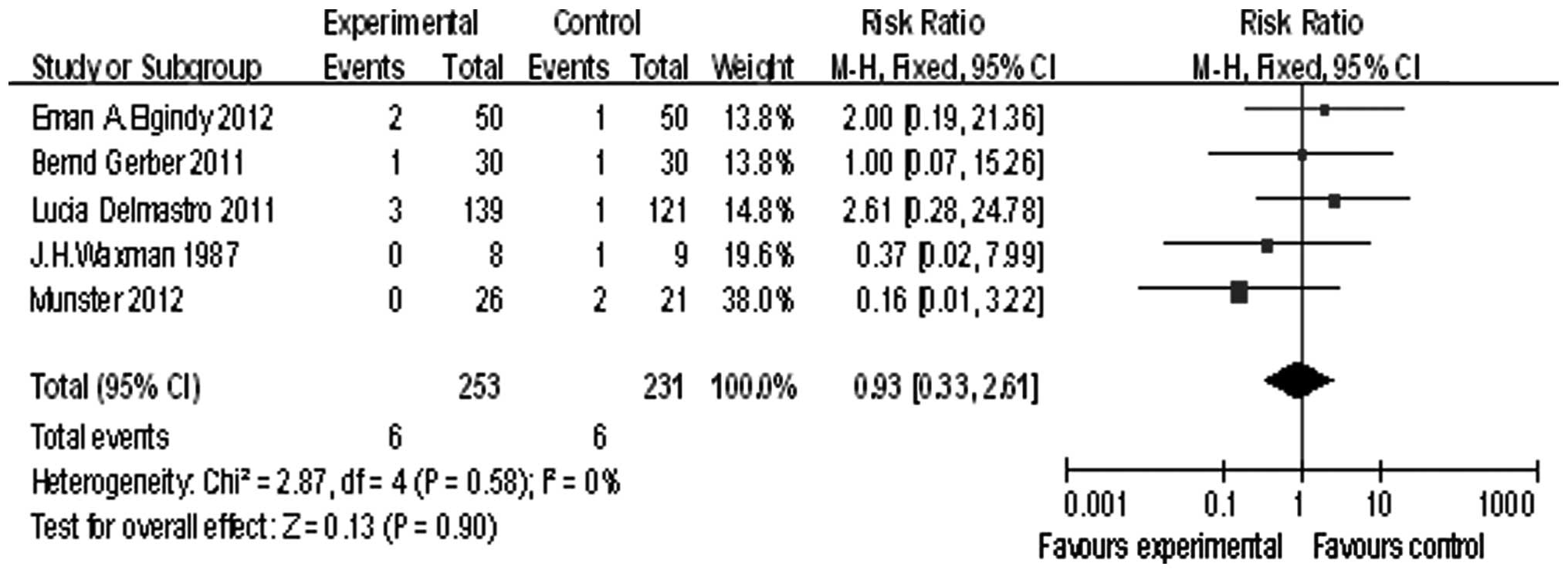Protection of ovarian function by GnRH agonists during chemotherapy: A meta-analysis
- Authors:
- Published online on: February 11, 2014 https://doi.org/10.3892/ijo.2014.2296
- Pages: 1335-1340
Abstract
Introduction
The survival rates of malignant diseases such as breast cancer, lymphoma and leukemia, are increasing (1), because of the improvements in therapeutic techniques. However, premature ovarian failure (POF) is an established long-term adverse effect of chemotherapy in young women. The POF can lead to infertility and amenorrhea and typical climacteric symptoms such as palpitations, heat intolerance, hot flashes, night sweats, irritability, anxiety, depression, sleep disturbance, decreased libido, hair coarseness, vaginal dryness, and fatigue (2), which have a significant impact on the quality of life of young women.
Younger women of childbearing age are confronted with the risk of infertility by chemotherapy-induced amenorrhea. Though a number of options to preserve fertility are available, such as cryopreservation of oocyte, embryo or ovarian tissue, ovarian transposition and hormonal protection with GnRH analogs (3), the latter has an edge over the others since it is less invasive and more convenient.
Animal studies and phase II clinical research have suggested that GnRHa can lead to temporary ovarian suppression to preserve ovarian function (4–6). Recently, several studies have been conducted on the ovarian function preservation in young women undergoing gonadotoxic chemotherapy. But the conclusions drawn from these studies are not unanimous. There were also some reviews and meta-analysis on the topic, some of which came up with the results that GnRHa can benefit the ovarian function following chemotherapy (7,8), while one of the studies produced the conclusion that the benefit of using GnRHa for fertility preservation in young breast cancer patients remains uncertain (9). In the present study, we conducted a meta-analysis to assess the efficacy of GnRH agonists in protecting the ovaries against chemotherapy induced damage in premenopausal women with malignant diseases.
Materials and methods
Data sources and searches
The electronic medical literature databases including Pubmed, MELINE, Cochrane library, Embase, CNKI and Wanfang, were explored for available articles on the topic published till November, 2013 using crosslinking keywords. Articles in Chinese and English were included. Only randomized controlled trials (RCTs) were selected. The keywords included fertility, ovarian failure, ovarian preservation, chemotherapy and GnRHa. Reference lists were also searched for additional studies. The experimental groups were prescribed GnRHa while undergoing chemotherapy and the control group underwent chemotherapy without GnRHa.
Study selection
Two investigators reviewed each study. The following inclusion criteria were used to select the studies for our meta-analysis: i) premenopausal females under the age of 46 undergoing potentially gonadotoxic chemotherapy; ii) a control group suffering with similar ailments, who were undergoing chemotherapy but were not given GnRHa; iii) a clear definition to evaluate ovarian function, such as recurrence of menses, level of follicle-stimulating hormone (FSH). If the study have repeated publications, we took the one with the most complete data. The following studies were excluded: i) the studies were not RCTs, such as case-control design, reviews, letters or case reports; ii) publications in languages other than Chinese and English; and iii) studies with a dropout rate of greater than 10%.
Data extraction and quality assessment
The data were extracted by two reviewers independently, the terms were as follows: i) the basic information of author, year of publication, country of the study, study type; ii) patient population, type of disease, age; iii) GnRHa dose, timing; iv) chemotherapy regimens; v) definition of premature ovarian failure; and vi) duration of follow-up.
The methodological quality of each study was assessed in accordance to the guidelines in the Cochrane reviewers’ handbook (Version 5.1.0) (10). The following trial features were assessed: i) random sequence generation; ii) allocation concealment; iii) blinding of participants and personnel; iv) blinding of outcome assessment; v) incomplete outcome data; vi) selective reporting; vii) other sources of bias. The evaluations were categorized as ‘low risk’, ‘high risk’ or ‘unclear risk’ of bias. If all the qualities criteria were judged low risk, the trial was considered to have low risk of bias (score A); if one or more qualities criteria were judged unclear risk, but no one were judged high risk, the trial was considered to have moderate risk of bias (score B); and if one or more qualities criteria were judged high risk, the trial was considered high risk of bias (score C). The publication bias was also assessed using funnel plot.
Statistical methods
In this meta-analysis, the main outcomes were the post-chemotherapy ovarian function. All analyses were performed with Review Manager statistical software (Review Manager 5.1). Dichotomous data were used to calculate the risk ratio (RR) and 95% confidence interval, the heterogeneity of the RR were also tested. In the Q test, it was considered heterogeneous if P<0.1, while in the I2 statistic, 0 to 40% were deemed not important; 30 to 60% might represent moderate heterogeneity; 50 to 90% might represent substantial heterogeneity; and 75 to 100% considerable heterogeneity (10). A fixed-effect model was used when there was no heterogeneity, when the heterogeneity present could not be readily explained; a random-effect model was used. In this meta-analysis, our results showed P=0.0002, I2=72% indicating that there was substantial heterogeneity, so a random-effect model was employed. In the overall results, P<0.05 signifies that GnRHa has a positive effect in preserving the ovarian function.
The publication bias was also assessed by funnel plot, which was plotted by Review Manager 5.1. Using RR as abscissa and standard error of RR napierian logarithm as ordinate, bias was considered to be under control if the funnel plot was symmetrical.
Results
After the databases were thoroughly investigated, 394 articles were selected, then applying the inclusion and exclusion criteria, eight RCTs composed of 621 patients were included (Fig. 1) (11–18). A total of 321 women were treated with GnRHa during their chemotherapy, while 300 women underwent chemotheray without GnRHa. The comprehensive characteristics are shown in Table I. Women in five of the trials had breast cancer, two had lymphoma and one had ovarian malignancy. The GnRHa used in the RCTs included triptorelin, goserelin, buserelin and dipherelin. The standard dose was maintained and most of the GnRHa were administered by subcutaneous or intramuscular injection, but in one of the cases, it was given intranasally (13). In all trials, the first dose was administered at least one week prior to chemotherapy in order to avoid chemotherapy during the expected ovarian flare. We found that there were certain inconsistencies in the ways POF were defined in the trials; five (11–14,16,17) of them were defined as amenorrhea only, while two trials had considered its association with the follicle-stimulating hormone (FSH), estrodiol (E2). The types of chemotherapy regimen used and the number of cycles were also taken into account. Two trials (11,18) had a follow-up duration less than 12 months, others had maintained follow-up for more than 12 months. All the trials included were evaluated to have low or moderate risk of bias according to the methodological quality assessments in the Cochrane reviewers’ handbook (version 5.1.0) (10).
Eight studies reported POF, we tested the heterogeneity of the RR [τ2=0. 5; χ2=16.32, df=7 (P=0.02); I2=57%], and because of the heterogeneity of the RR, a randomized model was used. The summary RR was 0.45, and the 95% confidence interval was (0.22, 0.92), P=0.03 (Fig. 2). This demonstrated that GnRHa exerted its positive effects in preserving the ovarian function by preventing POF.
Eight studies reported the rate of menstruation recovery, the summary RR was 1.25, and the 95% confidence interval was (0.99, 1.58), P=0.06 (Fig. 3). This result showed GnRHa can improve the menstruation recovery rate.
Five of the studies reported pregnancy, the summary RR was 0.93, and the 95% confidence interval was (0.33, 2.61), P= 0.90 (Fig. 4). The pregnancy rate showed no significant difference between the GnRHa group and the chemotherapy alone group.
Four studies involved patients younger than 40 years, the summary RR was 0.26, and the 95% confidence interval was (0.07, 0.96), P=0.04 (Fig. 5).
Publication bias was assessed by the use of a funnel plot, the plot was basically symmetrical and the distribution of most of the points was in an inverted funnel manner.
Discussion
The mechanism of action by which GnRHa preserves ovarian function is not clear, but may include: i) the interruption of FSH secretion and inhibition of follicles from entering the growing stage; ii) reduction of ovarian perfusion; iii) protection of ovarian germline stem cells directly; and iv) upregulation of phingosine-I-phosphate (19).
Based on the meta-analysis we conducted, there was evidence that GnRHa could preserve the ovarian function following chemotherapy in young pre-menpausal women. POF has been referred to as a form of hypogonadism that manifests as premature menopause or development of amenorrhea due to cessation of ovarian function, only two trials considered the level of the FSH, E2. However, POF is rather an ovarian insufficiency than ovarian failure since the women with POF have been reported to conceive despite limited ovarian function. Ravdin et al showed that young breast cancer patients retain their ovarian function following chemotherapy despite the absence of menstruation (21). However, infertility typically proceeds to menopause by within ten years (25). Thus we consider that the former definition has certain limitation since amenorrhea is not the best standard for determination of fertility. The diagnosis is based on detection of elevated FSH that is approaching menopausal level (usually above 40 IU/l) at least two measurements conducted a few weeks apart (20). Apart from FSH, other hormonal indicators such as anti-mullerian hormone (AMH), estradiol (E2), inhibin-A and B have also been implicated with the accurate determination of ovarian functions. Anderson et al came up with an effective method for determining the residual ovarian function after chemotherapy which involved the measurement of AMH along with ultrasound-guided antral follicle count (22).
Among the trials in our analysis, four (11,14,16,18) were conducted on patients younger than 40 years. Because of the limited data, we could not estimate the precise function of GnRHa in this patient group. This leads to a bias in our analysis since ovarian function has a natural tendency to decline along with age. Also there is a possibility of data contamination due to the involvement of the environmental factors. The data analyzed have a wide geographical variation thus we can not exclude the possibility of a varied susceptibility of women towards POF due to the environment they were exposed to.
Tamoxifen is a known independent risk factor which can affect menstrual cycles. One study (23) showed that the rate of amenorrhea in patients treated with goserelin alone was 64% compared to 93% in patients treated with goserelin combined with tamoxifen. However, of the five trials including patients with breast cancer, there was a lack of control for confounding effects of tamoxifen.
Only three of the trials were followed up for more than 2 years. For those women who recovered menstruation, there is an additional long-term risk of POF (24). The long-term POF reports do not exist; and one-year follow-up can not evaluate the ability of fertility well. Thus, long-term follow-up is needed.
The first injection of the GnRHa was generally one or two weeks before chemotherapy, only two trials (16,17) proved ovarian suppression before chemotherapy. Ovarian suppression was not confirmed on chemotherapy administration and ovaries could be in ‘flare-up’ interval. In this condition, the GnRHa might not perform well.
Some heterogeneity existed in the trials we analyzed, which presumably creates a potential bias on the results we obtained. For instance the heterogeneity in the chemotherapy regimen could affect our results. Similarly the variation in the length of follow-up duration also has certain impact in determining the actual results. On the contrary, one of the strength of our study was the inclusion of bilingual literatures in English and Chinese. The study criteria were determined carefully and the methodological quality of each trial included in this analysis was assessed following the standard protocol in the Cochrane reviewers’ handbook.
In this meta-analysis, we have deduced the beneficial role of GnRHa in preserving the ovarian function of the young women undergoing chemotherapy, but the ability to preserve fertility was not proved. However, more well-designed trials with appropriate age limitation (<40 years old) and a more sensitive marker of ovarian reserve are needed before it is established as a standard therapy.
Acknowledgements
The study was conducted at Qilu Hospital, Shandong Medical University and was supported by the National Natural Science Foundation of China (81072121, 81372808, JJ and 81173614, LQT) and the science and technology developing planning (2012G0021823, JJ), (2011GSF12122, ZX) and also by science and technology developing planning of Jinan (201303035). We would like to acknowledge Mr Binglin Lv for his support for statistical analysis.
References
|
Surveillance, Epidemiology and End Results (SEER) Web site: Available online: http://www.seer.cancer.govApril2010 based on the November 2009 submission. | |
|
Beck-Peccoz P and Persani L: Premature ovarian failure. Orphanet J Rare Dis. 1:92006. View Article : Google Scholar | |
|
Sonmezer M and Oktay K: Fertility preservation in female patients. Hum Reprod Update. 10:251–266. 2004. View Article : Google Scholar | |
|
Bokser L, Szende B and Schally AV: Protective effects of D-Trp6-luteinizing hormone-releasing hormone microcapsules against cyclophosphamide-induced gonadotoxicity in female rats. Br J Cancer. 61:861–865. 1990. View Article : Google Scholar | |
|
Ataya K, Rao LV, Lawrence E and Kimmel R: Luteinizing hormone-releasing hormone agonist inhibits cyclophosphamide-induced ovarian follicular depeletion in rhesus monkeys. Biol Reprod. 52:365–372. 1995. View Article : Google Scholar | |
|
Del Mastro L, Catzeddu T, Boni L, et al: Prevention of chemotherapy-induced menopause by temporary ovarian suppression with goserelin in young, early breast cancer patients. Ann Oncol. 17:74–78. 2006.PubMed/NCBI | |
|
Clowse ME, Behera MA, Anders CK, Copland S, et al: Ovarian preservation by GnRH agonists during chemotherapy: A meta-analysis. J Women’s Health. 18:311–319. 2009.PubMed/NCBI | |
|
Yang B, Shi W, Yang J, Liu H, Zhao H, et al: Concurrent treatment with gonadotropin-releasing hormone agonists for chemotherapy-induced ovarian damage in premenopausal women with breast cancer: A meta-analysis of randomized controlled trials. Breast. 22:150–157. 2013. View Article : Google Scholar | |
|
Turner NH, Partridge A, Sanna G, Di Leo A and Biganzoli L: Utility of gonadotropin-releasing hormone agonists forfertility preservation in young breast cancer patients: the benefit remains uncertain. Ann Oncol. 24:2224–2235. 2013. View Article : Google Scholar : PubMed/NCBI | |
|
Higgins JPT and Green S: Cochrane Handbook for Systematic Reviews of Interventions. Version 5.1.0. The Cohran Collaboration (updated March 2011). | |
|
Badawy A, Elnashar A, El-Ashry M and Shahat M: Gonadotropin-releasing hormone agonists for prevention of chemotherapy-induced ovarian damage: prospective randomized study. Fertil Steril. 91:694–697. 2009. View Article : Google Scholar : PubMed/NCBI | |
|
Munster PN, Moore AP, et al: Randomized trial using gonadotropin-releasing hormone agonist triptorelin for the preservation of ovarian function during (neo)adjuvant chemotherapy for breast cancer. J Clin Oncol. 30:533–538. 2012. View Article : Google Scholar | |
|
Waxman JH, Ahmed R, Smith D, Wrigley PEM, et al: Failure to preserve fertility in patients with Hodgkin’s disease. Cancer Chemother Pharmacol. 19:159–162. 1987. | |
|
Loverro G, Guarini A, Di Naro E, et al: Ovarian function after cancer treatment in young women affected by Hodgkin disease (HD). Hematology. 12:141–147. 2007. View Article : Google Scholar : PubMed/NCBI | |
|
Del Mastro L, Boni L, Michelotti A, Gamucci T, Olmeo N, et al: Effect of the gonadotropin-releasing hormone analogue triptorelin on the occurrence of chemotherapy-induced early menopause in premenopausal women with breast cancer: a randomized trial. JAMA. 306:269–276. 2011. | |
|
Elgindy EA, El-Haieg DO, Khorshid OM, et al: Gonadatrophin suppression to prevent chemotherapy-induced ovarian damage: a randomized controlled trial. Obstet Gynecol. 121:78–86. 2013.PubMed/NCBI | |
|
Gerber B, von Minlkwitz G, Stehle H, Reimer T, et al: Effect of luteining hormone-releasing hormone agonist on ovarian function after modern adjuvant breast cancer therapy: The GBG 37 ZORO study. J Clin Oncol. 29:2334–2341. 2011. View Article : Google Scholar : PubMed/NCBI | |
|
Gilani MM, Hasanzadeh M, Ghaemmaghami F, et al: Ovarian preservation with gonadotrop in releasing hormone analog during chemotherapy. Asia Pac J Clin Oncol. 3:79–83. 2007. View Article : Google Scholar | |
|
Blumenfeld Z: How to preserve fertility in young women exposed to chemotherapy? The role of GnRH agonist cotreatment in addition to cryopreservation of embryo, oocytes, or ovaries. Oncologist. 12:1044–1054. 2007. View Article : Google Scholar : PubMed/NCBI | |
|
Goswami D and Conway GS: Premature ovarian failure. Hum Reprod Update. 11:391–410. 2005. View Article : Google Scholar | |
|
Ravdin PM, Fritz NF, Tormey DC and Jordan VC: Endocrine status of premenopausal node-positive breast cancer patients following adjuvant chemotherapy and long-term tamoxifen. Cancer Res. 48:1026–1029. 1989.PubMed/NCBI | |
|
Anderson RA, Themmen AP, Al-Qahtani A, Groome NP and Cameron DA: The effects of chemotherapy and long-term gonadotropin suppression on the ovarian reserve in premenopausal women with breast cancer. Hum Reprod. 21:2583–2592. 2006. View Article : Google Scholar : PubMed/NCBI | |
|
Sverrisdottir A, Nystedt M, Johansson H and Fornander T: Adjuvant goserelin and ovarian preservation in chemotherapytreated patients with early breast cancer: results from a randomized trial. Breast Cancer Res Treat. 117:561–567. 2009. View Article : Google Scholar : PubMed/NCBI | |
|
Partridge A, Gelber S, Gerber RD and Castiglione-Certsch M: Age of menopause among women who remain premenopausal following treatment for early breast cancer: long-term results from International Breast Cancer Study Group Trials V and VI. Eur J Cancer. 43:1646–1653. 2007. View Article : Google Scholar | |
|
Te Velde ER and Pearson PL: The variability of female reproductive ageing. Hum Reprod Upadate. 8:141–154. 2002.PubMed/NCBI |














